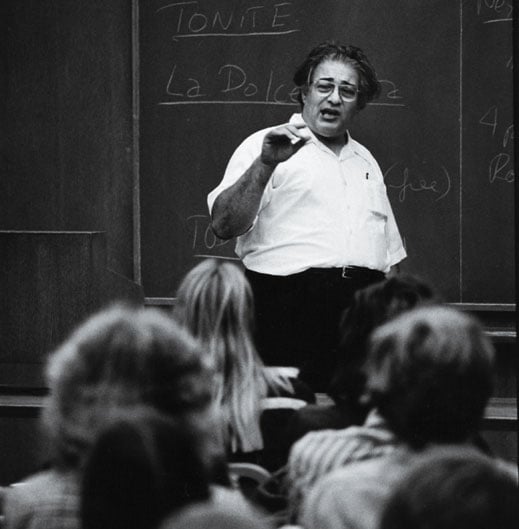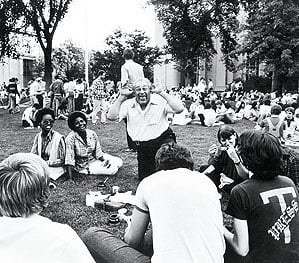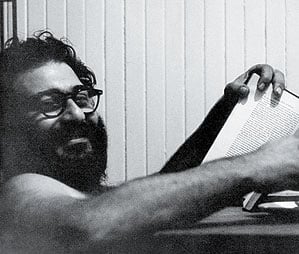In a Frog’s Eye
When MIT materials science professor Robert Rose entered Jerome Lettvin’s office in the basement of Building 20 on a fall day in 1968, he immediately heard a problem. “I heard this screeching noise that sounded exactly like a bearing about to fail,” he recalls. “And I knew something was wrong, so I said, ‘Professor Lettvin, you may have a fire!’” As Rose peered around the room looking for the source of the sound, Lettvin seemed unfazed. When he lifted up the lid of a 50-gallon trash bin, the noise became deafening. “There was a cricket colony in there. One million crickets!” says Rose. “ ‘Professor Lettvin,’ I asked, ‘why do you have a cricket colony in your office?’ And he said, ‘To feed my frogs.’”

By then Lettvin, a professor of electrical and bioengineering and of communications physiology, was famous for his research on frogs. “What the Frog’s Eye Tells the Frog’s Brain,” which he’d published a decade earlier, was “viewed as a seminal paper in cognitive science,” according to his longtime colleague Joel Moses, Institute Professor of electrical engineering and computer science. It became one of the most cited scientific papers of all time and laid the groundwork for advances in neuroscience, physiology, and cognition research. But at MIT, where Lettvin had arrived as a researcher in 1951, he was known as much for his outsize personality, his love of language, and his thirst for debate as he was for his groundbreaking research. Although he died in 2011 at age 91, and his last graduate student earned his PhD in 1989, countless stories about him live on.
Lettvin’s MIT legacy is especially remarkable because his was a career that almost wasn’t. Trained initially as a doctor in his native Chicago, he had wanted to be a poet. In school, one of his mentors took him aside and said, “Look, do you really want to go to medical school? Why don’t you go out and become a writer? Doctors are a dime a dozen but the writers are not.”
Lettvin would pen poetry throughout his career, publishing poems and essays in literary journals; when he was elected to the American Academy of Arts & Sciences for his scientific achievements, he was one of a select few who lived up to its full name. But his mother had matter-of-factly stated, “No medical school, no support,” so he stuck with medicine, earning his MD in 1943 from the University of Illinois. After an internship at Boston City Hospital and several years practicing psychiatry in the Army, he concluded that psychiatry was not as fascinating as the anatomy and physiology behind what makes us think. When the war ended, he spent the next several years working furiously to reinvent himself.
In 1946, Lettvin returned to Boston as a full-time neurologist at the Veterans Administration, auditing physics and higher mathematics classes at MIT and conducting research on the side. Following a motion sickness project at the University of Rochester, he went back to Illinois and lived a double life as a psychiatrist and the head of his own physiology lab at a now-defunct state hospital. In 1951, after half a decade of hectic work (he would later speak of getting three to four hours of sleep per night for much of that time), he landed a full-time entry-level position at MIT’s new Research Laboratory of Electronics.

At MIT, Lettvin set out “to devise new approaches to problems in neurophysiology, and to define these problems more and more clearly,” he wrote in a 1958 CV. Two years earlier, he’d gotten interested in vision and, as he put it, “decided to play with frogs.” The choice was hardly capricious: he could inject frogs with tubocurare to temporarily paralyze them without affecting the sensory systems he wanted to study—and without killing them. Although tubocurare is lethal to mammals (arrows laced with it quickly shut down their lungs), it doesn’t harm frogs, which breathe through their skin.
Before Lettvin’s frog studies, the retina was viewed as a receptor of light that merely sent signals to the brain for interpretation. “The assumption has always been that the eye mainly senses light, whose local distribution is transmitted to the brain in a kind of copy by a mosaic of impulses,” he wrote. Instead of accepting that assumption, he attached electrodes to the frog’s optic nerve so he could eavesdrop on the signals it sent. He then positioned an aluminum hemisphere around the frog’s eye and moved objects attached to small magnets along the inner surface of the sphere by moving a large magnet on its outer side. By analyzing the signals the optic nerve produced when viewing the objects, Lettvin and his collaborators demonstrated the concept of “feature detectors”—neurons that respond to specific features of a visual stimulus, such as edges, movement, and changes in light levels. They even identified what they called “bug detectors,” or cells in a frog’s retina that are predisposed to respond when small, dark objects enter the visual field, stop, and then move intermittently. In short, Lettvin’s group discovered that a lot of what was thought to happen in the brain actually happened in the eye itself. “The eye speaks to the brain in a language already highly organized and interpreted, instead of transmitting some more or less accurate copy of the distribution of light on the receptors,” he concluded.

These important results were initially dismissed. “We had the utmost trouble. We were laughed off the stage, literally, at the American Physiology Society in Atlantic City, where we tried to present it,” Lettvin told his collaborator Luis Amador in 1986. The NIH even threatened to withdraw his grant if he didn’t “start behaving,” he recalled. Then he got his break. “IRE [the Institute of Radio Engineers] was after me to write a paper on electrodes,” he told Amador. “I made a trade with them—I’d write the paper on electrodes if they would publish the paper on the frog’s eye.” The editor’s response? “All right, but we want a good paper on electrodes.”
Even after the paper was published in 1959, the findings met with considerable skepticism. One disgruntled scientist—fellow MIT researcher Walter Rosenblith—”felt we were … liars, held a meeting on perception, visual perception, and didn’t invite us,” Lettvin told Amador. Another colleague circumvented the snub by taking conference attendees on an unannounced visit to his lab so they could see for themselves how the experiment was done. The visiting audience was convinced, and Rosenblith soon apologized. “And that,” Lettvin concluded, “was the time that we began to be taken seriously.”
He himself was hardly serious all the time, though. As a university student, he studied in a Chicago strip club. He wrote poetry on toilet paper during the Battle of the Bulge. And he proposed after three dates, saying, “Most people get to know each other and then get married. How about we do it the other way around?” says Maggie, his wife of 64 years. “He told outrageous stories,” Rose says, but “he led a fairly outrageous life, so you never knew which one was true.” A skilled debater, Lettvin “loved to argue” says Moses, and “knew so much about so many things.” He could conjure up well-articulated positions on the fly, delivering them with eloquence—and often with colorful language. (“His favorite word,” Maggie says, “was ‘bullshit.’”) His crowning performance was a nationally televised 1967 debate about LSD with the former Harvard psychologist Timothy Leary, an advocate of psychedelic drugs. When Leary’s original opponent backed out and organizers asked Lettvin to fill in at the last minute, he was “up to his shirtsleeves in an experiment, but he walked right over and did it,” his son Jonathan recalled in 2011. After Leary extolled the benefits of LSD, Lettvin responded with an engaging 17-minute lecture. “The kick is cheap. The ecstasy is cheap. And you are settling for a permanent second-rate world by the complete abrogation of the intellect,” he told a packed audience in Kresge.

In the classroom, Lettvin put on an equally good show. Maggie, who lived in Bexley Hall when she and her husband served as housemasters in the late 1960s and early ’70s, would overhear students talking about a history of science class that he took over to help an ailing colleague get his pension: they’d say “Come and bring your lunch, bring your girlfriends. Lettvin is teaching,” she says. “Classes would last three or four hours.” But Lettvin was perhaps at his best holding forth at the giant table in his Building 20 office, where, Rose says, colleagues loved “schmoozing and arguing and calling each other names.” That environment, Rose says, served as “a model of what academia ought to be.” The opening stanza of Lettvin’s poem “Elegy for Building 20” captures it well: “Place of work is part of mind/Memories imprint the wall/Shabby artifacts recall/Crystal concepts, well-defined.”
When friends and colleagues paid tribute to Lettvin on his 60th birthday, a former student sent a telling telegram: “Friend to students, friend to janitors, friend to the elite and friend to the strays, friend to man and especially friend to girls, you are the enemy only of complacent dogma (and, of course, frogs).”
Keep Reading
Most Popular
Large language models can do jaw-dropping things. But nobody knows exactly why.
And that's a problem. Figuring it out is one of the biggest scientific puzzles of our time and a crucial step towards controlling more powerful future models.
The problem with plug-in hybrids? Their drivers.
Plug-in hybrids are often sold as a transition to EVs, but new data from Europe shows we’re still underestimating the emissions they produce.
Google DeepMind’s new generative model makes Super Mario–like games from scratch
Genie learns how to control games by watching hours and hours of video. It could help train next-gen robots too.
How scientists traced a mysterious covid case back to six toilets
When wastewater surveillance turns into a hunt for a single infected individual, the ethics get tricky.
Stay connected
Get the latest updates from
MIT Technology Review
Discover special offers, top stories, upcoming events, and more.